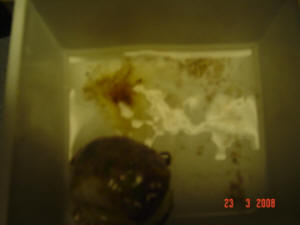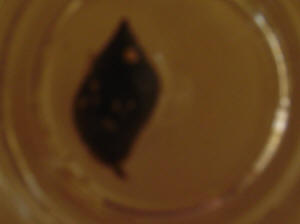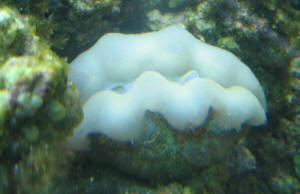|
FAQs about Giant Clam Disease: Nutritional
FAQs on Giant Clam Disease:
Tridacnid Disease 1,
Tridacnid Disease 2, Tridacnid Disease 3, Tridacnid Health 4,
Tridacnid Health 5, Tridacnid Disease 6, Tridacnid Disease 7, Tridacnid Disease 8, & Pest Snails (Pyramidellids...),
FAQs on Giant Clam Disease by Category:
Diagnosis,
Environmental, Social, Trauma,
Pathogenic,
Treatments
Related Articles: Tridacnid Health: Pinched
Mantle Syndrome in Giant Clams by Dr. David Basti, Deborah
Bouchard & Barry Neigut, Got Tridacna? A beginner's guide to
keeping Tridacnid clams by Laurie
Smith, Example Chapter
from NMA Reef Invertebrates book, on Giant Clams, Tridacnids, A Brief Guide to the
Selection and Placement of Tridacnid Clams by Barry Neigut,
Bivalves, Mollusks, Lighting Marine
Invertebrates,
Related FAQs: Tridacnid Identification, Tridacnid Behavior, Tridacnid Selection, Tridacnid Compatibility, Tridacnid Systems, Tridacnid Lighting, Tridacnid Placement, Tridacnid Feeding, Tridacnid Reproduction, Tridacnids 1, Tridacnids 2, Tridacnids 3, Tridacnids 4, Tridacnid Clam Business, Bivalves, Bivalves 2, Lighting Marine
Invertebrates,
|
Tridacnids (actually all life) requires N, P, K....
Measurable Nitrates and Phosphates to hobbyists. W/o these essential
nutrients they will die in short order.
|
|
clam problem, English, no useful info., using WWM
3/26/08 last night before shutting down my light system on my
140 reef all of the animals and coral were fine open and happy
.this morning I awoke to a horrible sight my baby crocea was dead
.it is kind of hard to explain what it looked like when I took it
out of the tank there was this mass that had the consistency of gel.
I will be including a picture . I believe that to be what's left
of him. <Bizarre that this should happen so quickly... Your
pix are very hard to make out> I was wondering if it could of
been a snail .I have heard that there's a snail that attacks
clams . <... your English... and no searching...> The clam
was in the sand also I don't know if that a facto .also ph
8.2 ammonia 0 nitrate0,nitrite 0. in the picture with the clam
the watery looking stuff is like a jelly fish feeling to it .
texture <Read here: http://wetwebmedia.com/tridacdisfaqs.htm
and the linked files above. B>
Re: clam problem, English, no useful info, using WWM -
3/28/08 I don't know if this is useful information for
you or not (and like you said the pictures are not the clearest).
The second picture (the one of the snail) looks suspiciously like
a LR hitchhiker I removed from my main tank after I caught him
feeding on (what I think is) a tube worm or non mobile snail) of
some kind. I tried to do some research on the predator at the
time and found that it indeed was known to feed on other inverts
(especially the non-mobile types). <<I see>> I
can't remember where I found it now and tried looking for it,
but mine looks kind of like a gray tulip snail.
<<Mmm'¦best to 'evict' then>> Since
this is the first time I've written I'd also like to say
thank you for teaching me that everything (at least most
everything) I learned from my mother about keeping a marine tank
is incorrect. <<'¦?>> After reading through
your pages for the last 6 months or so I'm amazed that her
overstocked 29g long does as well. I also wish I had found you
before I had setup my tank (a 40g tall) I'd have made very
different decision if I had. <<Ah'¦>> Keep
up the good work, Jason
<<We are trying. EricR>>
|
|
 
|
|
Clam troubles... no data of use, not
reading... 2/21/08 Hi! <Howzit?> I have a
newly setup 330g main tank and 70g sump setup in December. As a
part of the new tank I migrated from a well established 46 gallon
reef tank. I had a maxima clam and a Crocea clam I have kept for
over 2 years in my 46g tank. However, last week I lost my Crocea
clam and my maxima is fading quickly (clam not opening very wide,
sinking mantle, bleaching of mantle). The new tank water quality
is kept very clean, stable pH, temp, water parameters are great,
salinity 1.025, calcium is a bit low but climbing 350-380.
<Alkalinity, Magnesium?> I am dosing every other day w/ DT
phyto. <... of not much use in this setting> After the
Crocea perished I dosed the maxima in a separate container with
tank water and heavy dose of DT phyto, despite this the maxima is
still declining quickly. The tank is kept under 1600 watts of (4
x 400w HQI halides). The clam is kept on a flat rock laying in
the sand substrate. <... may well need to be elevated...>
Given the new tank would you suspect: The maxima clam size is
about 4". 1.) The tank is to new and does not contain enough
natural phyto and other items in water column needed for health
of this clam. <...> 2.) A water quality or chemistry
problem. <Possibly> 3.) A light problem <Likely>
Thanks for all of your help as always! Bryan <Please read
here: http://wetwebmedia.com/tridcacdisf5.htm and the linked
files above... You need to know a bunch more... and provide more
data... For now, read. Bob Fenner>
Re: clam troubles... lack of nutrient... 2/21/08
Thanks, I did some reading on that URL. <Okay> The maxima
perished. Alk is 11 dKH, calc is about 390. ammonia: 0 nitrites:
0: nitrates: barely detectable. I had always thought under
halides keeping a clam on the substrate was doable, <Mmmm>
I have seen several healthy looking clams in other tanks like
this. The tank is 30" tall and the halides are about 7"
off the top of the aquarium. I obviously want to figure out what
went wrong before buying anything else. <This depth... the
light would have to be directly above...> Given the slow
decline I didn't speculate it was a pest. <Agreed> The
only thing recently I have changed in the tank was the addition
of PhosBan media per your teams recommendation. <...! Clams
(actually all life... e.g. ADP, ATP...) absolutely require
"some" soluble phosphate... This sudden removal may
well have been a factor> Within 2 weeks, both clams are gone.
Coincidence? <Not likely> I have not tested phosphate prior
to this, and I had no reason to believe I had a phosphate
problem, I simply added it as a precaution for long term health.
<... I would not have done this... there are other, easier
means of phosphate limitation, control... Posted on WWM> Is
your bet still on light? <Partly... but am hedging/spreading
my bets more and more. How about you?> Best Bryan <Bob
Fenner>
|
| Clams making a fashion statement? Bleached
Tridacnids 9/23/07 Hey Gang :) <Lisa> Here I
am again with a question. (big surprise huh?) <Oh yes!> I
have 3 crocea clams in my tank. They've been there for about a
year. They all had pretty good color until about a month or so ago.
Now two of them are completely faded, the biggest has gone from
purple to brown. They otherwise seem very healthy. The light has
not changed since we upgraded in January to a 520 watt system which
provides about 5.7watts per gallon to our 90 gallon Oceanic
bowfront. I had the water tested Wednesday at the LFS just to
double check my own results, and the quality is excellent (Ph 8.3,
nitrates 0 nitrites 0, ammonia 0, phosphate 0). They
didn't test calcium, alkalinity was 13. SG is 1.026. <This
all looks okay... except that the clams do actually need some
nitrate, phosphate... and some folks speculate even ammonia> So
knowing lighting hasn't changed, water quality is excellent
(everything else is thriving), what can I do to help my clams
regain their color? <More nutrient I believe... What do you feed
these Tridacnids?> Thanks again so much, I'm lost without
y'all. Lisa <You have read here:
http://www.wetwebmedia.com/tridacfdgfaqs.htm and the linked files
above? Bob Fenner> |
|
 .jpg) Bad Bad
|
Tridacna stroke? - 6/2/05 I have a Tridacna maxima in my
29gal reef that has been great for the few months I have had it.
<Actually says very little unfortunately. It can take up to nine
months for a healthy specimen to starve to death. A slow death indeed.
This is the case with a lot of Tridacnid species as they don't get
all their nutritional needs from light alone.> The past few days he
has only opened on one side. <Weird.> I know that is hard to
picture but imagine what a clam would look like after having a stroke.
He is lying horizontal and the left side is colorful and looks as it
has, but the right side is tucked away. <Maybe something irritating
the mantle by way of stinging or picking at it?> All other corals,
fish and inverts are doing fine. <Doesn't help me to further
identify your situation any better without knowing more about your
tank. Size is good but what about inhabitants (specifically fish and
corals and other inverts), water chemistry, lighting, and any other
thoughts that might come to mind. Thoroughness really goes a long way
in diagnosis. Can't help much here except possible predation on the
mantle or irritation from chemo reactants (i.e.. coral aggression
through allelopathy) or again possible starvation.> Is this normal
or is my clam in danger? <Very likely in danger> Thanks for your
much appreciated help! <Please read through our articles and FAQ
response to Tridacnid care. See if there are any questions/answers
describing your situation. Thanks for being part of it all. ~Paul>
Clam question
Hello there- My father says WetWebMedia has given him lots of great
advice- I have a question about Tridacnid clams (purple/blue (not
maxima)......I've had a couple for about a year or so, and they
both died the other day, both within about 24 hours. All I
could see was what looked like clear snot, and what looked like pieces
of sand in the mucus, .....the clams closed up, and they seemed to have
a hole in the bottom of them......the only thing that seemed to be near
the clams, were brown tiger tail cucumbers. Have you seen this before?
Thanks for your help..... DaveB <Hello Dave, Have you fed your clams
weekly? Marine Snow is a good product to use.<<Uhh,
not in all's opinion here. This product is a placebo IMO... has
VERY little nutritional value>> It's not necessary
to feed daily, a once a week feeding should be
enough. <<Barry Neigut suggests a minimum of 3 times per
week... and NOT Marine Snow>> Also, do you change your bulbs
on a yearly basis? Clams do require strong light of the
proper spectrum. Just cause the light lights doesn't
mean the full spectrum is still there. Most clams will only
do well under metal halide lighting. James (Salty Dog)>
Clam exudation 3/27/03 Greetings! I
have a blue Tridacna maxima, about 5 inches below the surface of the
water under a 175W MH with 40W of fluorescent actinic. The
clam is about two years old. Recently I have noticed that in
the evening, I see a very thin brown strand of (I assume)
Zooxanthellae algae coming out of the exhalant siphon.
<could be... sometimes they are expelled naturally in small packets,
other times induced by stress (increase in light as with new bulbs or
clarity as with water change or sudden use of carbon)> The clam is
well extended and looks great. Water parameters are great
and unchanged, except that I recently (1 month ago) noticed that the pH
was dropping to 8.00 during the night. I slowly used Reef
Buffer to raise the pH to about 8.45 during the day, dropping to about
8.30 at night. Salinity is 1.025 and nitrites are zero, and
nitrates are 5ppm. <all good> I use PolyFilter and an
Urchin Pro. Is this algae discharge normal? thanks tom
<likely no worries at all. Be mindful not to overfeed (at risk of
clogging gills) with liquid supplements too. Best regards,
Anthony>
Re: Clam exudation 3/27/03 Thanks for your
response, Anthony. I have been feeding liquid food, perhaps
a little bit more than usual. This afternoon I noticed some
bleached spots on the mantle which weren't present this
morning. The mantle is open/out. <not good signs at
all... and rules out coagulated food from overfeeding as the primary.
Stress from a physical parameter is more likely now... the sudden
influx of a larger than normal bit of freshwater perhaps for belated
evap top-off? Dosing supplements in strong concentration near it at the
top of the tank (sans dilution in sump or strong stream). Hmmm... many
possibilities. Predation is more common in general but would not
expectedly cause the bleach spots. Instead we are looking for stress or
disease here. Perhaps a new fish or coral added recently without QT
brought in a pathogen> Any suggestions? thanks, tom <watch
nightly for predators, but otherwise do not disturb while evaluating
water quality. A water change is usually helpful too (dilution of the
unknown). Anthony>
|
|

